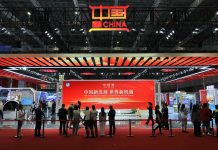DM Monitoring
LOS ANGELES: The Port of Long Beach, U.S. second busiest port, announced Friday the completion of a 1.5-billion-U.S.-dollar new container terminal designed to become one of the most technologically advanced cargo facilities in the world.
“This terminal can move 3.5 million containers per year,” Mario Cordero, Executive Director of the Port of Long Beach told Xinhua at a completion ceremony here in southern California.
“And any time you talk about needing more capacity, you are talking about China,” he noted.
With two thirds of the port’s imports coming from China, Cordero is confident that terminal will be beneficial to both sides.
“Our goal is to operate as efficiently as possible and this terminal is a grand example of that,” said Cordero, as he described the new terminal, which took over a decade to plan, design and build, as “the greatest achievement at the port of choice, a wonder of the maritime industry.”
“It was well worth the investment,” said Cordero. “The Port of Long Beach ‘s mission for their new terminal is to create efficiency and reliability. In an age of e-commerce, consumers expect their products tomorrow. And we have an Amazon frame of mind,” he added.
While capacity in most terminals on the U.S. West Coast have remained static, the Port of Long Beach’s additional capacity will bring it a greater speed and efficiency reflected in its berth productivity, speed of trucks through their gates, and the velocity of their rail system throughput, the largest in North America.
“Additional capacity means more cargo, more supply chain jobs, a strengthening of our regional and national economy,” said Long Beach Container Terminal CEO Anthony Otto.
The cost of shipping a 40-foot container from China to U.S. West Coast has soared from 11,000 dollars in July to almost 20,000 dollars this week, shows Freightos index, giving rise to some concern that these exorbitant fees will negatively impact on the terminal’s business.
But Cordero was unconcerned. “High rates aren’t going to impact this terminal. We’re very busy.”
He pointed out that the carriers charging an arm and a leg now were the same ones that suffered during the 2008-2009 global recession when the rates bottomed out.
“That’s all just part of the larger economic equation,” he shrugged, adding that the COVID-19 pandemic has been the real disruption here, more so this past year than the trade war.
The executives said the Port of Long Beach is one of the most sustainable container terminals in North America, with a chock full of electric cranes and a robotic transport system operating at 90 percent fewer emissions than competing docks.
He noted that it is truly a technological marvel that will allow the port to increase its throughput, improve air quality and maintain its status as a leading gateway for trans-Pacific trade.
Regarding labor issues, he also pointed out that longshore workers displaced by the automated systems are being retrained to operate the control center and provide maintenance on the new machines.
The San Pedro Bay ports of Los Angeles and Long Beach in southern California handle approximately 40 percent of all containerized imports and 30 percent exports for the United States.
The Port of Long Beach alone handles trade valued at around 170 billion dollars annually and supports 2.6 million jobs across the nation and one in every five jobs in Long Beach.






